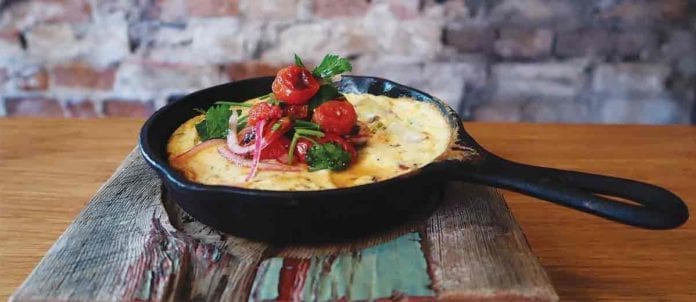Food trends can be shifty concepts, easily influenced by increasingly tough competitive environments, rising food and labour costs and changes in customer preferences. “I’d be very happy if I knew what the trends were going to be ahead of time,” says Nick Benninger of Waterloo, Ont.-based Fat Sparrow Group, which operates Harmony Lunch in Waterloo. “What I do know is breakfast is now the fastest-growing trend in the industry. We’re working hard to capture a good breakfast crowd at Harmony Lunch.”
Breakfast is big in an era when other dayparts are perceived by diners as expensive: it’s the diametric opposition to more costly lunches and drawn-out dinners and is getting more attention. With a younger, urban clientele less likely to eat at home — and certainly less likely to eat soggy cereal and milk — breakfast has seen a rise in popularity in the past several years.
Benninger cites a growing urban population and what he calls a “condo culture” that sees an increasing number of young adults eating out — breakfast included. “Millennials in general eat out more than any generation prior,” Benninger says. “It makes sense that we see growth at breakfast and brunch. It’s largely due to the creativity of chefs and restaurateurs who have worked hard to reinvent a category of dining in an effort to fill seats during slower times.” Harmony Lunch serves what it calls a “proper” waffle ($10) along with a Breakfast Sammy, which re-works its 1930s diner-classic pork slider with an over-easy egg, apple-pickle salad and home fries ($12).
Millennial demographics or not, time and a focus on healthy eating are factors driving people to eat breakfast away from home. According to executive chef Robert Mills of Epic Restaurant in Toronto’s Fairmont Royal York Hotel, he’s seeing increased weekday visits from locals. “We’ve seen an increase in demand with our à la carte menu options, as our guests either do not have as much time to enjoy a full breakfast or prefer not to eat as much,” says Mills.
As a result, he says the kitchen strives to meet a few keystone trends that are a part of the general food and dining milieu. “We take great pride in our ingredients being local, seasonal and sustainable.” That includes adding the property’s unique rooftop-produced honey to its cooking and using home-grown herbs in specialty dishes. For many diners, that artisanal-crafted touch is now an expectation at breakfast.
THIRD-WAVE COFFEE
The crafted touch also includes coffee — something inextricably linked to breakfast. The so-called “third wave” of coffee — a movement that considers the artisanal and crafted aspect of coffee as opposed to only its commodity value — has made an impact at breakfast, according to U.S.-based market-research firm IBISWorld.
Ordering a morning cup of Joe is increasingly viewed as “an experience” for many demographics and that includes consumption in restaurants. High-quality single-origin coffee, siphoned coffee, AeroPress and French-press coffee are more expensive but speak to the quality many diners have been seeking since Starbucks grande’d its way into the Canadian market.
Such coffee products have even nudged traditional coffee-shop chains to bolster their offerings with new and richer coffee beverages. The consequence of that is the breakfast foods associated with morning coffee have, in places, evolved from nutrient-hollow sweet pastries to low-fat flatbreads with egg whites, apple-bran muffins, multi-grain rolls and “power-protein” plates.
BOLD AND ASSERTIVE
“Natural” is trending for the morning daypart. Kale, specifically, is noted as a fast-growing breakfast ingredient — but with more unusual flavours such as apple-pickle salad appearing on menus, according to Technomic’s Aaron Jourden.
“While some of the fastest-growing breakfast dishes and drinks include iced coffee, Belgian waffles and smoothies, pesto, garlic, mint and ginger are other fast-growing flavours. They are bold and assertive and often associated with lunch or dinner,” Jourden says. He adds “free-from” foods, local sourcing and transparency are also influencing breakfast menus at the chain-restaurant level.
Epic’s smoothies are, well, epic, says Mills, and they don’t feature the usual breakfast-ingredient suspects. “We have a lot of guests who favour our Green Monster smoothie with spinach, celery, green apple and kale ($12). You can pair it with a pumpkin-seed muffin and fresh fruit for a popular option.” Alternatively, Epic’s Superfruit smoothie ($12) provides an antioxidant-rich blend of blueberry, acai, pomegranate and Greek yogurt.
An independent operator — one who says he benefitted from an appearance on Food Networ’s Diners, Drive-in and Dives — Vancouver’s Brad Miller says a similar healthy breakfast is big in his Hastings Sunrise neighbourhood restaurant. At the Red Wagon Café, big-flavoured and healthy “Buddha” or “power bowls” appear as menu specials.
“Other than that, we’re staying pretty [true] to what we do because our customers come to us for specific things. We try not to change too much, though our specials might lean out there a bit,” says Miller. That includes items such as a tofu breakfast scramble with smoked mushrooms and basil ($10) and a crispy pork-belly plate featuring eggs served with confit pork belly, grilled tomato, salsa verde, Hollandaise and homefries ($14).
Miller has embraced the “natural” trend and the popularity of the farm-to-table movement at breakfast at his restaurant, but only to a degree that is reasonable for him and good for his customers. “I want to give people what they want for breakfast, but I can’t price myself out of the game. Vegetarian dishes are becoming more popular and gluten-free is a big thing.” It might not be surprising, given the city’s demographics, but Asian flavours are also popular, and the small venue is well known for its pulled-pork buttermilk pancakes with Jack-Daniels syrup ($15). A banh mi breakfast dish is also popular, says Miller.
While the flavours of Asia are emerging as the new kids on the breakfast block, Mexican ingredients are becoming influential, too, according to Jourden. “Chorizo, avocado and black beans are among the fastest-growing ingredients on breakfast menus over the past two years.” He also points out that Italian flavours are showing modest influence on this daypart. Brunch fills seats, too The breakfast cousin, brunch, is showing a marked increase in interest among morning eaters; it’s a significant part of Red Wagon’s business, says Miller. “We opened as a diner and the very first Saturday brunch was a real scramble,” he says. The interest in Red Wagon grew from there. “It gave us a chance to forge ahead and do what we want to do.”
In fact, “forging ahead” with brunch is perhaps an example of what other restaurants might want to consider. According to Technomic, among the top 250 Canadian chains, brunch is relatively “underpenetrated” at about two per cent of operators who list it on their menus, says Jourden. “It’s certainly something full-service chains are looking at and even fast-casuals and quick-serves may look to leverage this opportunity.”
No need to tell that to an independent such as Benninger, who says fried chicken and waffles for brunch are hugely popular. He recognizes imaginative and inventive brunches are great for restaurateurs.
“It stretches breakfast service into and well past traditional lunch service,” he says. “Appetites are big and customers are willing to splurge on big-ticket items such as Lobster Eggs Benedict,” he says, adding coffee and orange juice often yield to an alcoholic beverage to boot.
“With rising [operational] costs, we’re always looking for creative ways to get people out during times we are traditionally slow,” Benninger says. “Weekend lunches for us traditionally don’t start until 1 p.m. or so, so tempting folks with a creative brunch menu has helped fill that void.”
Written by Andrew Coppolino


















